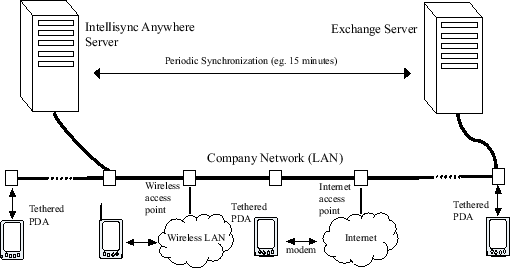



Next: SyncML
Up: Scalability in Mobile Device
Previous: Hotsync
Contents
The Intellisync Anywhere [19] product family from Pumatech
always makes synchronization `Fastsync enabled' by using one
central server to which mobile devices always synchronize. This
means that all synchronizing devices have to maintain status flags
of updates with respect to only the central server, allowing for a
Fastsync every time. Figure 2.6 shows a typical
company network using the Intellisync architecture to setup and
maintain a mobile device network for a Microsoft Exchange server.
Information held at the exchange server is used to update
information held on the Intellisync server. In addition, changes
made by end users are stored on the Intellisync server and
periodically synchronized with the exchange server. This periodic
synchronization will result in a delay in the time it takes for
updates made on the Exchange server to be available to users.
The centralized approach creates a central point of failure. If
the central server is congested, the entire network suffers. In
addition, scalability with the number of devices in the network is
a serious issue because the load on the server increases linearly
with increasing devices in the network.
Figure 2.6:
Intellisync Anywhere server installed on a company's
network
 |
On the upside, there are many secondary benefits of a centralized
scheme, including the feasibility of centralized security policy
and easier methods of broadcasting information in an
organization's network (such as policy changes, event schedules
etc.).
The EDISON architecture proposed in [20] also relies on a
centralized, shared server with which all hosts synchronize. The
server maintains an incremental log of updates so that the hosts
can always use Fastsync instead of Slowsync (see Section
2.2.1). This architecture is not designed for the
general case where a device may synchronize with any other device
on a peer-to-peer basis. In general, a distributed architecture
based on peer-to-peer synchronization provides much better network
performance, in terms of robustness and scalability, than a
centralized architecture [21,22,23].




Next: SyncML
Up: Scalability in Mobile Device
Previous: Hotsync
Contents
Sachin Kumar Agarwal
2002-07-12
